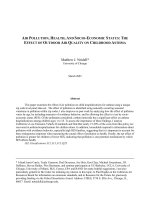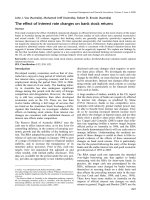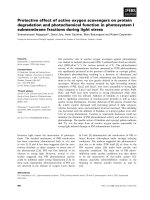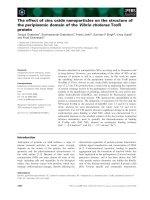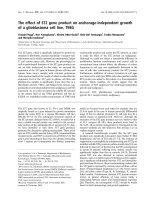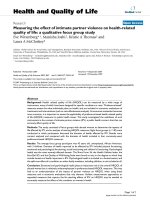The effect of perceived brand globalness on brand value and purchase intention
Bạn đang xem bản rút gọn của tài liệu. Xem và tải ngay bản đầy đủ của tài liệu tại đây (1.53 MB, 64 trang )
UNIVERSITY OF ECONOMICS HO CHI MINH CITY
International School of Business
------------------------
Dinh Thi Mai Trang
THE EFFECT OF PERCEIVED BRAND
GLOBALNESS ON BRAND VALUE
AND PURCHASE INTENTION
MASTER OF BUSINESS (Honours)
Ho Chi Minh City- Year 2014
UNIVERSITY OF ECONOMICS HO CHI MINH CITY
International School of Business
------------------------
Dinh Thi Mai Trang
THE EFFECT OF PERCEIVED BRAND
GLOBALNESS ON BRAND VALUE
AND PURCHASE INTENTION
ID: 22120077
MASTER OF BUSINESS (Honours)
SUPERVISOR: Dr. LE NHAT HANH
Ho Chi Minh City- Year 2014
ACKNOWLEDGEMENTS
First of all, I would like to express my deepest appreciation to Dr. Le Nhat
Hanh for her professional guidance from the very first day of research till the
finishing. Her helpful advices and encouragement during my research preparation
are grateful. Without her help, it would have been impossible for me to complete
this research.
I would like to send my appreciation to ISB- UEH professors for their
expertise and encouragement during the master course. Also thanks for their
valuable time for the proposal examination committee. Their comments and
suggestions are significant for my research's complement.
I am also grateful to my MBUS classmates for their knowledge sharing,
expertise and spending great moments together. Besides, I want to say thanks for
the participants who filled my questionnaires out. The participants donated their
precious time to finish the questionnaires and helped me to acquire the data soon.
Last but not least, I would like to express my gratitude to my parents, family
members, colleagues and friends for their support and understanding throughout
my post graduate study. Their unconditional love, sympathy and encouragement
have made this research and my MBA course possible.
ABSTRACT
In recent year, together with globalization of the world market, it is
important to understand the competition between local and global brands, and
whether customers prefer global brands. This study aims to investigate the effects
of perceived brand globalness on brand value, which in turns affect customer
purchase intention. Brand value is manifested via brand credibility, brand prestige,
and brand quality. The conceptual model is tested by using structural equation
modeling. 309 consumers who live in from Ho Chi Minh City were recruited as
respondents for this research. From statistical analysis, we find that Perceived
brand globalness is positive related to both perceived brand quality and perceived
brand prestige, which then significantly increase consumer purchase intention. It
also shows the critical role of brand credibility in leading to perceived of the
quality of any brand. This research provides important implications for developing
global brand in Vietnam market and also for local brand.
Key words: Purchase intention, brand globalness, consumer behaviors, brand
quality, brand prestige
TABLE OF CONTENTS
ACKNOWLEDGEMENTS
ABSTRACT
TABLE OF CONTENTS
LIST OF FIGURES
LIST OF TABLES
CHAPTER 1: INTRODUCTION ........................................................................... 1
1.1 Research background .................................................................................... 1
1.2 Research gap ................................................................................................. 3
1.3 Research objective ........................................................................................ 4
1.4 Research scope .............................................................................................. 4
1.5 Research contribution.................................................................................... 5
1.6 Research structure ......................................................................................... 5
CHAPTER 2: LITERATURE REVIEW ................................................................ 7
2.1 Theory of Plan Behavior (TPB) ..................................................................... 7
2.2 Purchase intention (PI) .................................................................................. 9
2.3 Perceived brand globalness (PBG) ................................................................ 9
2.4 Brand credibility (BrC) ............................................................................... 11
2.5 Perceive brand prestige (PBP) ..................................................................... 12
2.6 Perceived brand quality (PBQ) .................................................................... 13
CHAPTER 3: RESEARCH METHODOLOGY ................................................... 17
3.1 Research procedure ..................................................................................... 17
3.2 Sample ........................................................................................................ 18
3.3 Data collection and procedure ..................................................................... 19
3.4 Scale and measurement: .............................................................................. 20
3.5 Questionnaire design ................................................................................... 21
3.6 Data analysis method .................................................................................. 23
CHAPTER 4: DATA ANALYSIS ....................................................................... 24
4.1 Sample characteristic .................................................................................. 24
4.2 Confirmatory Factor Analysis (CFA) .......................................................... 26
4.3 Structural equation modeling (SEM) ........................................................... 31
CHAPTER 5: CONCLUSION, IMPLICATIONS AND LIMITATIONS ............. 38
5.1 Conclusion .................................................................................................. 38
5.2 Managerial implication ............................................................................... 39
5.3 Limitations and future research ................................................................... 41
REFERENCES .................................................................................................... 42
APPENDICES ..................................................................................................... 52
Appendix A: Questionaire (English) ................................................................. 52
Appendix B: Questionaire (Vietnamese) ........................................................... 54
LIST OF FIGURES
Figure 2.1 Conceptual model
16
Figure 3.1 Research procedure
18
Figure 4.1 Standardized CFA model in AMOS
29
Figure 4.2 Structural Equation Modeling result
32
Figure 4.3 Mediator analysis
35
LIST OF TABLES
Table 3.1 Source of measurement scale & Questionnaire
22
Table 4.1 Respondents’ characteristic
25
Table 4.2 Response frequency of brands
26
Table 4.3 Fit statistics of Confirmatory Factor Analysis
27
Table 4.4 Standardized Regression Weights
28
Table 4.5 Scale accuracy analysis
30
Table 4.6 Correlation matrix of research constructs
31
Table 4.7 Fit statistics of SEM
32
Table 4.8 Hypothesis testing result
33
Table 4.9 Summary of hypotheses testing result
37
1
CHAPTER 1: INTRODUCTION
1.1 Research background
In a globalizing world, many international firms have moved from a multilocal to
a global branding strategy (Ozsomer & Altaras, 2008; Steenkamp et al., 2003). Due to
Ozsomer et al (2012), global branding is understood as firms market their products on a
global basis with only limited adaptation to local markets. It standardizes aspects of its
brand communication program like name, logo, image, packaging, positioning and
consumers in multiple countries consider to be global (Akaka and Alden, 2010). In
contrast, local brand is defined as brand that exists only in one country or in a limited
geography area (Wolfe, 1991). Many multinational corporations today are altering their
brand portfolios in favor of global brands (Steenkamp, Batra and Alden, 2003) which
are brands that consumers can find under the same name in multiple countries with
generally similar and centrally coordinated marketing strategies (Yip, 1995; Branch,
2001).
Globalness is perceived in mind of consumers and is called perceived brand
globalness (Steenkamp, Batra and Alden, 2003). Perceived brand globalness has been
researched mostly in the fast-moving consumer goods sections in highly developed
countries, whereas the effect on retailer brand equity in emerging countries remains
unclear.
In Vietnamese context, many global brands are very successful compare to other
local brands. It began from late 1980s when Vietnam opened its market and welcomed
foreign investment and trading. Until now, besides agricultural products, food
processing products, textile… which are our domestic strengths products, almost other
global productions have greater market share compare to the same local brand
productions. The research of International Business Publication (2013, p.130) showed
that foreign brand have proliferate in Vietnam over the past decade. Vietnamese
2
consumers also remarkably familiar with foreign products even though they are not
available in Vietnam due to internet access and contact to their foreign relative living
abroad. Vietnamese consumers, especially young people seem to prefer global brand.
An assessment of a big fast- food brand in the world McDonald’s stated that “Vietnam
has been at the top of McDonald's list of the next market to open for a very long time”
(Maresca, 2014). Another example is the recent event of Starbucks store in Ho Chi
Minh City. On the opening day, it attracted a lot of young customers who were willing
to stand in long queues and wait for a long time for their chance to sample the ‘new’
coffee (The Saigon Times, 2013). This also is a value example for the readiness of
Vietnamese customer toward foreign product.
Actually, there is the challenge for local brands to get their market share and
compete with other global brand within local market. But building our local brand value
has just been taken care recently. And it seems that Perceived brand globalness is really
a new concept that very few Vietnamese brands have been successful in building an
image as a global brand. It is the fact that few Vietnamese corporate reaches the level of
multinational company. Moreover, to expand their business to an emerging market,
retailers need to build the differentiation to distinguish themselves from local
competitors in target market. Some reasons for moving toward global brands are yield
economies of scale and scope in Research and Development, manufacturing and
marketing (Yip, 1995); increases meaningful segments of consumers around the world
develop similar needs and tastes (Hassan and Katsanis, 1994); speed up time to market
by reducing time-consuming local modifications (Neff, 1999). Almost Vietnamese
businessman should find the way to develop their products and increase sales by
exporting.
This research will investigate the ways that global brand and perceived brand
globalness affects purchase intention, whether the globalness of a brand play a vital role
3
in determining consumer purchase intention. This is significant for foreign brand when
penetrating to Vietnamese market. And also for local brands, which are not recognized
by foreign market, consider if they want to bring their products abroad.
1.2 Research gap
The concept of Perceived brand globalness and the effects of Perceived brand
globalness to Purchase intention were investigated by some researchers with different
accesses. Most of the empirical study of Steenkamp (2003), Holt (2004), focused on the
pathway through Perceived brand quality and perceived brand prestige. Consumer
prefers import products due to their superior quality. It was showed that Purchase
intention be affected by customer’s perceived brand globalness toward perceive of its
higher quality and brand prestige through word of mouth or observation. This pathway
is also moderated by Consumer Ethnocentrism, a well-established bias among many
consumers in favor of home-grown productions (Shimp & Sharma, 1987). The next
trend of accessing this effect is proving the important of customer- based reputation
which implies high quality productions and services offered by company, as well as the
certainly that it would treat its customers well (Carmeli & Tishler, 2005; Greenwood,
Li, Prakash & Deephouse, 2005). Another point of view, perceived brand globalness
affects purchase intention by Brand credibility as a mediating variable. If a brand is
view as globally available and, thus, there is global acceptance for the product,
consumer may perceive the brand is more credibility than local brands (Ozsomer &
Altaras, 2008). But there is no other study concentrated on this mediating effect of
Brand credibility on the relationship of perceived brand globalness and purchase
likelihood. It is just as an integrated conceptual framework as Ozsomer and Altaras
(2008) did suppose.
Moreover, the majority of researches have been conducted in developed
countries. Actually perceived brand globalness is not meaningful in advanced economic
4
because consumer tends to perceive local product with higher quality than import one
(Dickerson, 1982; Herche, 1994). In contrast, with an emerging market, just few
researches worked on this concept, and most of them stated that production quality is
the most meaningful attribute to consumers due to experiencing the low-quality of local
production. However to evaluate the quality of a production is not an easy task
(Nguyen, Nguyen & Barrett, 2008). Moreover, Batra and his colleagues (2000) find a
direct relationship between the perceived nonlocalness of the brand and attitude toward
the brand, where nonlocalness was measured by perceptions of multimarket reach. And
other studies focused on direct relation of different factors while in this study,
researcher examine the role of Brand credibility as a mediating variable affect customer
purchase intention in transitional market like Vietnam.
Therefore the conceptual model of this study is showed the effect of perceived
brand globalness to brand values which includes brand credibility, perceived brand
quality, perceived brand prestige, and then to customers purchase intention.
1.3 Research objective
The overall objective of this study is to examine how Perceived brand globalness
influences the intention to purchase global brands. Specifically, it investigates:
- The effect of Perceived brand globalness on brand value which are perceived
brand quality, perceived brand prestige, brand credibility
- The effect of Perceived brand globalness on Brand purchase intention through
brand values.
1.4 Research scope
This research is conducted in Ho Chi Minh City due to the fact that Ho Chi Minh
City is one of the biggest and developed cities in Vietnam. Most of international brands
centralized here, so people living here have more opportunity to consume most of
5
international product and get their intentions of choosing to consume any of production.
The three target groups in Ho Chi Minh City, with the first two groups are students from
high schools and universities and the other group is office staffs categorized by their age
ranging to represent teenagers and adult workers which will mix gender. The time frame
is 1 month after pilot test was agreed.
Qualitative research was conducted firstly to confirm the reality of the
questionnaire, and also the reliability of Vietnamese questionnaire. The interviewees
were classmates and colleagues of researcher. After that, the final questionnaire was
fitted and the quantitative research was conducted to collect data for confirm the
research’s objective.
1.5 Research contribution
Base on the findings in the end of this research, we hope to contribute a basic
view of customer toward global brand in Vietnam, particularly to international
companies who have the intention to expand their business to Vietnam, especially Ho
Chi Minh City market. Actually, every manager has to understand deeply when
deciding to penetrate to the new market in order to maximize opportunities and
minimize obstacle. This study is useful for foreign investors understand what
Vietnamese customer need, and then have the straight strategy to attract and maintain
customers’ loyalty. Moreover, it also works for local brand managers who want to make
their brands survive and compete in an emerging market like Vietnam.
1.6 Research structure
The research is divided into five chapters. The introduction chapter demonstrates
background of the research. Furthermore, this chapter briefs some previous research that
is relevant and helpful for the author to look for the research gap. Deriving from
research gap, the research questions and research objectives are also generated. The
6
study scope is also mentioned in this chapter. Chapter two reviews and synthesizes the
theories of six concepts, including Perceived brand globalness, Brand credibility,
Perceived brand quality, Perceived brand prestige, Brand purchase intention. This
chapter also shows previous research, hypotheses, and the conceptual model. The third
chapter covers research methodology used to empirically test the research model. Next,
the analysis and result chapter shows the steps of data processing. The last chapter
discusses summarily the study findings, suggests some recommendations for any new
business strategy on branding and building a brand image. Moreover, this chapter
covers the limitation of the research and suggestion for further study.
7
CHAPTER 2: LITERATURE REVIEW
This chapter mainly introduces the Theory of Planned Behavior (TPB, Ajzen,
1991) and its application to purchase intention of imported product, and constructs
which are proposed by many scholars in academic field, related to each factors in the
research model of the study. After that, Perceived brand globalness concept is
introduced to clarify specially about perceived global brand definition. Continuously,
the related theories of each construct, including Brand credibility, Perceived brand
quality, Perceived brand prestige, Brand purchase intention are discussed respectively.
Finally, research model is proposed, and also its constructs and relationship
hypothesized among these constructs.
2.1 Theory of Plan Behavior (TPB)
Theory of Planned Behavior (Ajzen, 1991) is an extension of Theory of
Reasoned Action (TRA) which was introduced by Fishbein and Ajzen in 1975, due to
the original model’s limitation in dealing with behavior. According to TRA, individual
intention to perform a given behavior correlates with actual behavior and determined by
two basic components which are attitude toward behavior and subjective norm.
Attitudes represent an individual’s overall evaluations of the behaviour as positive or
negative. Subjective norms assess the perceived social pressures to perform or not
perform a particular behavior. TRA could adequately predict behaviors that were
relatively straightforward (i.e. under volitional control), under circumstances where
there were constraints on action, the mere formation of an intention was insufficient to
predict behavior (Armitage & Conner, 2001). Moreover, as Ajzen (1991) stated that
behavioral achievement depends jointly on motivation (intention) and ability
(behavioral control) is by no means new. It constitutes the basis for theorizing on such
diverse issues as animal learning (Hull, 1943), level of aspiration (Lewin, Dembo,
8
Festinger, & Sears, 1944), performance on psychomotor and cognitive tasks (Locke,
1965; Vroom, 1964), and person perception and attribution (Anderson, 1974).
Therefore, TPB was introduced to extend TRA by a measure of perceived
behavioral control. It suggested that behavior is best predicted by intention to perform
the behavior (Ajzen, 1991). Intention is influenced by attitude towards the behavior,
subjective norm and perceived behavioral control. Perceived behavioral control is
defined as the individual’s perception of the extent to which performance of the
behavior is easy or difficult for that individual. Perceived behavioral control is also held
to influence behavior directly when perceptions of control match actual control
(Armitage & Conner, 2001). Due to Ajzen (1991) the relative importance of attitude,
subjective norm, and perceived behavioral control in the prediction of intention is
expected to vary across behaviors and situations. And consistent with an emphasis on
factors that are directly linked to a particular behavior, perceived behavioral control
refers to people’s perception of the ease or difficulty of performing the behavior of
interest. Perceived behavioral control also refers to a specific behavioral context and not
to a generalized predisposition. According to TPB, perceived behavioral control and
behavioral intention can be combined to predict behavioral achievement.
In summary, to predict whether or not a person intends to carry out any action, it
should be come from thinking of whether people is favor on doing it (attitude), how
much people feels social pressure to do it (subjective norm), and whether or not people
feels control of their action (perceived behavioral control). By changing of these three
factors, it will increase the change of people carry out the action and also increase the
change of people actually doing it. This study focus on identify the factors influencing
the purchase intention of people towards global brands with the application of TPB
model. Moreover, additional independent variables are also being tested in this study.
9
2.2 Purchase intention (PI)
In marketing area, attitude of customer is one of the most important indicators for
marketers to achieve consumer insight. Consumers’ attitude is the consumers’ feeling
include good or bad, endorsement or preference towards product attribute, which is
considered as the criteria that consumers refer to make purchasing decisions (Hanzaee
& Jalalian, 2012)
Intentions are defined as plans or goals. It can be conceived as goal states in the
expectancy value tradition that are the result of a conscious take- time process, requires
some deliberation, and focuses on consequences (Loewenstein, Weber, Hsee, & Welch,
2001). Fishbein and Ajzen (1975) defined intention as a subjective probability
dimension involving a relation between himself and some actions.
Then Purchase intention means a consumer plans to purchase a particular product
or service in the future or even attitude towards a product and perception of product
(BusinessDictionary, 2013). In other words, purchase intention means consumers will
buy a product once again after they evaluate a product and find out that the product is
worth buying. Whereas consumers choose one particular product, the final decision on
accepting a product to buy or reject it depends on consumers’ intention. Purchase
intention can affect the buying decision of customers in the future (Fishbein & Ajzen,
1975). Attitude towards complementing a behavior is considered as an assessment of
the level that a person likes or dislikes to perform the behavior (Finlay et al, 2002).
2.3 Perceived brand globalness (PBG)
According to Yip (1995) and Steenkamp et al (2003), Perceived brand globalness
is defined as a perception that can be formed only if consumers believe the brand is
marketed in multiple countries and is generally recognized as global in these countries.
Manufacturers have products that are internally considered to be global because they
10
share similar technical specifications (Branch, 2001). Perceived brand globalness is
primarily achieved through the use of global symbols such as brand name, symbols,
themes, brand logo, spokesperson… in marketing communications. These brands are
built on powerful narratives with universal appeal, example for Levi’s, the myth of
independence; for Nokia, of connection (Cayla and Eckhardt, 2007).
Due to Ozsomer and Altaras (2008), the term “global brand” has been defined in
a variety of way in the literature. There are two distinct definitions this construct. One
of them, global brands are those that use similar brand name positioning strategy, and
marketing mixed in most of their target markets. It is based on marketing
standardization as global brand is building for benefit from strong economic scale and
scope. It means standardized brand can create significant cost saving in marketing,
research and development, sourcing and manufacturing (Buzzeell, 1968; Craig and
Douglas, 2000; Levitt, 1983; Porter, 1986; Yip, 1995). By this way, the global brand
will benefit from unique perceived image in all its markets, especially when targeting
global consumer segment (Hassan, Craft & Kortam, 2003; Hassan & Katsanis, 1991).
The second standard of identifying global brand is defined from the consumer
perceptions perspective (Alden, Steenkamp, & Batra, 2006). It extends the definition to
which the brand is perceived as global and marketed not only locally but also in some
foreign market. If a brand increases perceived as multimarket reach, the perceived brand
globalness increase as well (Steenkamp, Batra, & Alden, 2003).
Consumer perception of a “global” brand can be formed in one of two ways.
Firstly, consumers may found the same brand in other countries, through media
exposure, word of mouth (heard from friends or relatives who returned from oversea),
or their own travel abroad. Secondly, a brand can be observe by marketing
communication that used brand names, endorsers, advertising themes, packaging and
other symbols widely associated with a “modern”, urban lifestyle, even if it not
11
available worldwide (Alden et al., 1999). Despite of how consumer perceive brand as
global, the questions of interest here are whether consumer perceptions of brand
globalness affect purchase intention, especially in developing country like Vietnam.
2.4 Brand credibility (BrC)
Brand credibility is defined as a signal to be the believability of the product
position information contained in a brand, which depends on a brand’s willingness and
ability to offer what it promises to customers (Erdem & Swait, 2004). In other words,
“brand credibility is an extent to which the product position information contained in a
brand is perceived as believable” (Ozsomer & Altaras, 2008).
Brand credibility consists of two main components: trustworthiness and expertise
(Erdem & Swait, 1998). Trustworthy refers to the willingness of a firm to deliver what
they have promised. Expertise refers to the ability of a firm to actually deliver what they
have promised. And these trustworthy and expertise of a brand are based on the
cumulative impacts of all previous marketing and action taken by a brand (Kim, Beak &
Yu, 2010). If brand as signals begin to lose their credibility by not delivering what they
promised, their brand equity will be erode (Ozsomer & Altaras, 2008). Therefore
keeping brand credibility is very important.
According to Erdem and Swait (1998) brands with greater marketing- mix
consistency and greater brand investments, such as advertising, have been proved to
convey higher levels of credibility. Marketing-mix consistency means the degree of
harmony and convergence among marketing action and the stability of marketing
strategy over time (Erdem, Swait, & Valenzuela, 2006). It also showed the consistency
in product quality as leads to a low level of inherent product variability (Roberts &
Urban, 1988). Brand investments represent resource spent on brand to ensure that brand
promises will be kept and demonstrate long-term commitment to the brand (Klein &
12
Leffler, 1981). This reinforces the credibility of brand by compelling the firms to be
honest in their product claims and to deliver the promised production.
We proposed that global brands with greater brand investment and greater
marketing-mix consistency across major market and time are greater credibility
(Ozsomer & Altaras, 2008). Based on the preceding discussion, the following
hypothesis is advanced.
H1. The perceived brand globalness has positive impact on Brand credibility.
2.5 Perceive brand prestige (PBP)
Brand prestige is defined as the relatively high status of product positioning
associated with a brand (Steenkamp, Batra & Alden, 2003). Prestige is a significant
association related to global brands (Holt, Quelch, and Taylor, 2004; Steenkamp, Batra
and Alden, 2003). Certain consumers are said to buy global brands to enhance their selfimage as being cosmopolitan, sophisticated and modern (Friedman, 1990). Due to
Alden, Steenkamp, and Batra (1999) consumers tend to perceive the consumption of
prestige brands as a signal of social status, wealth, or power since prestige brands are
infrequently purchased and are strongly linked to an individual’s self-concept and social
image. In general, the higher prestige of the global brands may be due to the scarcity
and higher price compare to the local brands (Batra et al, 2000). It seems that higher
price and greater scarcity create greater inspirational, prestige appeal (Bearden and
Etzel, 1982). Moreover, research on developing countries of Bhat and Reddy (1998)
showed that the consumption of products from Western countries acts as a symbol of
status and prestige. American products also were associated as high prestige.
Consumers believe that brand globalness is linked to prestige and may enhance their
self-image by adding a touch of modernity to their personalities (Schuiling & Kapferer,
2004). We supposed the hypothesis here is
13
H2. Perceived brand globalness positively affects consumers perceived brand
prestige.
Actually, brand prestige does not all individuals at the same degree.
Consumption of prestige brand is varied according to susceptibility to other (Vigneron
& Johnson, 1999). According to O’Cass and Frost (2002), prestige brands differ from
non-prestige brands in some ways that may affect consumer’s purchasing motives to
improve their social standing and self-expression. Perceived brand prestige has a
greater effect on purchase intention when the product category is of high social display
value (Wong and Zhou, 2005). We replicate this relationship as follow
H3. Perceived brand prestige positively affects consumers purchase intention.
2.6 Perceived brand quality (PBQ)
Perceived brand quality is defined as consumers’ subjective evaluation of the
overall excellence of the product (Zeithaml, 1988) and the credibility of global brands
makes consumers associate high quality with these brands (Akram, Merunka, Akram,
2011). Perceived quality is an attitude that results from the comparison of consumer
expectations with the actual performance (Parasuraman et al., 1985). According to
Baldauf, Cravens and Binder (2003), perceived quality is evaluated about the product
for varied individual consumers according to their satisfaction. The perceived quality is
a key factor that many firms can create their competitive advantage in their relative
industry.
If a brand is viewed as globally available, consumers may attribute higher quality
to the brand because such quality is likely to be thought of as critical to global
acceptance (Kapferer, 1997; Steenkamp, Batra and Alden, 2003). Due to Dimofte et al.
(2008), global brands are developed for a global market with their main characteristics
being world wide availability and recognition as well as standardization across
14
countries. Therefore, global availability and acceptance is taken as evidence that brand
has to be as high quality (Steenkamp, 2014). As the finding of Akram, Merunka and
Akram (2011), global brands charge a premium price which also signals higher quality,
and advertising messages are often promoting higher quality. It is unlikely that bad
product can be successful around the globe (Steenkamp, Batra and Alden, 2003). It also
likely that in emerging and developing countries, consumers perceive global brands to
be of a higher quality than local ones (Batra etal.,2000; Bhardwaj etal.,2010). Therefore
we supposed a hypothesis
H4. Perceived brand globalness positively affects consumers perceived brand
quality.
There is some empirical evidences approach to brand effects on consumer
consideration and choice that perceived quality is one of the main direct routes through
which credibility effects materialize (Erdem & Swait, 1998). Wernerfelt (1988) stated
that higher signal brand credibility may increase consumer perceptions of quality.
Consumers may infer that more credible brands are higher in quality than less credible
brands. Credible brand may increase consumers’ quality perceptions (Aaker, 1999).
Moreover, there are some streams which are discussed in the research of Erdem
and Swait (1998) showed that production quality can be evaluated by brand credibility.
The first stream focused on brand invested and its reputation for high quality (Shapiro,
1985) can ensure its commitment to high quality. But they may lose their brand image if
the firm cheating and not give what they promised. Another stream believed marketingmix elements are signal of good quality. Packaging, advertising, and warranties are not
only providing direct production information, but also show indirect information on
product attribute (Spence, 1974). Warranties also were proposed by many other
researches of Boulding & Kirmani (1993), Grossman (1981), Lutz (1989) as a signal
that manufactures’ confidence in the quality of their product. There are also empirical
15
approaches showed that perceived quality is of the direct routes through which
credibility effects materialize (Erdem & Swait, 2004). Finally, as research of Wernerfelt
(1988) showed multinational firms can take advantage of their reputation for quality by
using the brand name of an established product for a new experience good. Therefore
we proposed the hypothesis as below
H5. Brand credibility mediates the relationships among perceived brand
globalness and global brand quality.
Perceived quality of strong brands adds value to consumers’ purchase
evaluations (Low & Lamb, 2000). The research of Supphellen and Rittenburg (2001)
also showed in developing country, the customers are fully aware that the quality of
local brands absolutely tends to be lower than foreign brand. The common observation
and recent empirical studies have shown that brands perceived as global induced better
quality ratings, which in turn increased desire to buy (Kapferer, 2001). In a recent
article, Bartikowski et al. (2010) commented that in the short run, higher quality
perceptions lead to increase profit due to premium prices. And in the long run, to
effective business growth, involving both market expansion and market share gains.
Above of all, Aaker (1991) did show in the research that the purchase decision is also
influenced by the perceived quality which is also an aspect of brand value that makes
consumers pay for certain products or services. So our hypothesis is
H6. Perceived brand quality positively affects consumers purchase intention.
The literature shows the most compelling force that drives the consumers to the
purchase intention of any global brand is the quality. According to Jacoby and Olson
(1985), perceived quality is the primary driver of purchase intention, regardless of
product category, consumer section and time frame. The quality perception plays a vital
role in determining consumer preferences for these brands because global is
synonymous of quality for consumers (Milberg & Sinn, 2008). Brand quality appears to
16
be linked directly with perceived prestige. For example, Steenkamp, Batra, and Alden
(2003) found that consumer value of a global brand is positively associated with both
brand prestige and perceived brand quality. But brand prestige just affects limited target
customers. As example of Steenkamp et al (2003) it is the concerned of each market or
segment (e.g., young urban consumers), product categories (socially visible
productions…), certain stages of market revolution (e.g., where global brand are a
novelty , extremely expensive, or scare (Ger et al, as cited in Steenkamp, 2003)).
Therefore we hypothesize:
H7. Compared to Perceived brand prestige, Perceived brand quality has a
stronger effect on purchase intention.
The conceptual model representing all hypothesized relationships between the
construct is as below.
Figure 2.1 Conceptual model
Perceived
Brand quality
Perceived
Brand
Globalness
Brand
Credibility
Brand
purchase
intention
Brand prestige
17
CHAPTER 3: RESEARCH METHODOLOGY
This chapter presents the research method was used for this study to test the
research model and hypotheses specified in chapter 2. Firstly, it starts with describing
the process to do the research. Next, the sampling method was outlined. After that the
data collection method and procedure was described. Then, measurement scales are
presented to develop questionnaire. An in-depth interview also was conducted to help
measurement scales clearer and understandable. Beside, this chapter aims at explicating
the research approach choice and presenting the purposes of using that method.
3.1 Research procedure
This research was carried out in five main states: (1) define research objectives;
(2) review literature to support and reinforce analysis in the next stage, as well as
develop research model and hypotheses based on initial theoretical fundamentally with
consideration of the current context; (3) the qualitative method by in-depth interview
and group discussion was applied to clarify the factors and to adjust measurement
scales of the research model, based on that finalizing the questionnaire; (4) precede
collection data from large-scale survey and then analysis of data by quantitative method
and; (5) testing hypotheses and then drawing conclusion and recommendation based on
the results obtained

